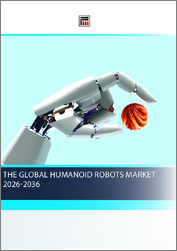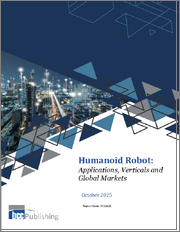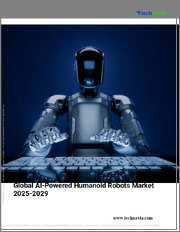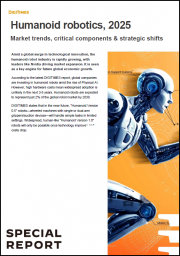
|
시장보고서
상품코드
1715154
세계의 휴머노이드 로봇 시장 예측(-2030년) : 유형별, 오퍼링별, 용도별, 지역별Humanoid Robot Market by Biped Robots, Wheel Drive Robots, Sensors (Gyroscopes, Accelerometers, Tilt Sensors, Position Sensors, Vision Sensors, Torque Sensors), Actuators (Electrical, Pneumatic, Hydraulic, Piezoelectric) - Global Forecast to 2030 |
||||||
세계의 휴머노이드 로봇 시장 규모는 39.2%의 CAGR로 확대하며, 2025년 29억 2,000만 달러에서 2030년에는 152억 6,000만 달러로 증가할 것으로 예측됩니다.
휴머노이드 로봇은 이미지 인식, 음성/음성 인식, 제스처 인식, 감정/상태 인식 등 여러 가지 복잡한 작업을 수행할 수 있습니다. 이러한 과정을 통해 자연 언어 처리 및 패턴 발견과 같은 지식 처리 기술을 사용하여 환경을 평가할 수 있습니다. 그 결과, 인터페이스 및 계획, 예측 및 최적화, 양방향성 및 추천 등의 기능을 통해 처리 의사결정 및 지원을 할 수 있습니다.
| 조사 범위 | |
|---|---|
| 조사 대상연도 | 2020-2030년 |
| 기준연도 | 2024년 |
| 예측 기간 | 2025-2030년 |
| 검토 단위 | 금액(10억 달러) |
| 부문별 | 유형별, 오퍼링별, 용도별, 지역별 |
| 대상 지역 | 북미, 유럽, 아시아태평양, 기타 지역 |
휴머노이드 로봇은 다양한 하드웨어 시스템 구성 요소의 협동 동작을 통해 지정된 작업을 수행합니다. 로봇은 카메라, 깊이 센서, 터치 센서 등 여러 센서를 사용하여 환경에 대한 인식을 수집합니다. 전기 모터와 유압 시스템으로 구성된 로봇의 작동 구성 요소는 물체 파악 및 실행 기능과 함께 보행을 위한 정확한 협동 동작을 수행하는 데 필요한 에너지를 공급합니다. 로봇의 작동 동력은 배터리 또는 전원 케이블에서 공급됩니다. 제어 시스템을 통한 신호 처리를 통해 고급 알고리즘이 자율적으로 실행되어 스마트한 의사결정 능력을 발휘합니다. 로봇의 전체 기능은 본체 재료, 전자, 전기, 기계 요소, 처리 시스템 등 여러 구성 요소에 따라 달라집니다. 이러한 물리적 시스템 요소의 조합을 통해 휴머노이드 로봇은 인간과 같은 형태를 취하여 의료 및 기타 연구, 교육, 엔터테인먼트 분야에서 작업을 수행 할 수 있습니다.
교육 분야에서 컴퓨터와 e-learning 플랫폼의 사용은 전 세계에서 교육의 접근성을 높이고 있습니다. 휴머노이드 로봇은 상황을 논리적으로 분석하고 인간의 학습을 지원할 수 있으므로 이 분야에서 중요한 역할을 하고 있습니다. 교육 분야에서의 휴머노이드 로봇은 전문적인 지식 없이도 로봇 기술을 시험해 볼 수 있는 플랫폼입니다. 휴머노이드 로봇은 개인화된 개인지도, 대화형 수업, 실시간 피드백, 언어 학습 지원 등 많은 기본 기능을 갖춘 턴키 솔루션을 제공합니다. 휴머노이드 로봇은 전통적인 강의, 온라인 동영상 학습, 교과서를 통한 자습과 같은 다른 교육 방법에 비해 지식과 실제 경험을 제공할 수 있습니다. 인간과 기계의 높은 수준의 상호 작용이 보장됩니다. 일부 교육기관에서는 이미 휴머노이드가 교실에서 교사를 보조하거나 교사를 대신하기 시작했습니다. 예를 들어 ROBOTIS(한국)가 제공하는 ROBOTIS MINI나 SoftBank Robotics(일본)가 제공하는 NAO는 교육용 휴머노이드 로봇으로 운영되고 있습니다. 휴머노이드 로봇은 다양한 언어, 수학, 일반 과학을 가르치고, 학생들이 철자법이나 스토리텔링을 배우도록 돕고, 기억력 게임에 참여할 수 있습니다. 아이들의 교육 도우미이자 게임 파트너이기도 합니다. 또한 학생들에게 과학, 기술, 공학, 수학(STEM) 커리큘럼을 가르칠 수도 있습니다. 이러한 로봇의 적응성은 학생 개개인의 필요에 따라 교수 스타일을 조정할 수 있으며, 보다 개인화된 인터랙티브한 학습 경험을 제공할 수 있습니다.
아시아태평양은 중국이 반도체, 전자부품, 전자칩, 센서 제조업체의 거점인 만큼 휴머노이드 로봇 시장에서 두 번째 점유율을 기록할 것으로 예측됩니다. 중국은 센서 기반 디바이스의 생산 및 판매에 있으며, 엄청난 잠재력을 가지고 있습니다. HANSON ROBOTICS LTD. 및 UBTECH ROBOTICS CORP LTD.와 같은 주요 로봇 제조업체의 본거지이기도 합니다. 중국은 인간형 로봇의 대량 생산을 향해 큰 진전을 보이고 있으며, 2025년까지 이 이정표를 달성할 계획입니다. 이 구상은 산업정보화부(MIIT)가 주도하고 있으며, MIIT는 국가 산업 전략의 핵심 요소로서 휴머노이드 로봇 개발에 대한 종합적인 로드맵을 제시하고 있습니다. 지난 20년간 중국의 급속한 경제 성장으로 중국은 제조업 주도형에서 기술 혁신 주도형 경제로 전환했습니다. 중국 정부는 이러한 전환을 주도하기 위해 필요한 고도로 숙련된 인재를 유치하기 위해 많은 연구 구상을 지원해 왔습니다. 계획된 성장 목표를 달성하기 위해 조만간 많은 로봇 제조업체가 중국 내에 등장할 것으로 예측됩니다. 중국에는 고령화 사회가 진행되고 있으며, 1억 명이 넘는 장애인이 있으며, 보조 및 간병용 로봇에 대한 수요가 증가하고 있습니다.
휴머노이드 로봇 시장에서 사업을 전개하고 있는 주요 기업의 CEO, 마케팅 책임자, 혁신 및 기술 책임자 등 다양한 경영진을 대상으로 심층 인터뷰를 진행했습니다.
세계의 휴머노이드 로봇 시장에 대해 조사했으며, 유형별, 오퍼링별, 용도별, 지역별 동향 및 시장에 참여하는 기업의 개요 등을 정리하여 전해드립니다.
목차
제1장 서론
제2장 조사 방법
제3장 개요
제4장 주요 인사이트
제5장 시장 개요
- 서론
- 시장 역학
- 밸류체인 분석
- 가격 분석
- 에코시스템 분석
- Porter's Five Forces 분석
- 주요 이해관계자와 구입 기준
- 사례 연구 분석
- 무역 분석
- 관세와 규제 상황
- 특허 분석
- 2025-2026년의 주요 컨퍼런스와 이벤트
- 고객 비즈니스에 영향을 미치는 동향/혼란
- 투자와 자금조달 시나리오
- 기술 분석
- AI/생성형 AI가 휴머노이드 로봇 시장에 미치는 영향
- 2025년 미국 관세의 영향-휴머노이드 로봇 시장
제6장 휴머노이드 로봇 시장(유형별)
- 서론
- 2족 보행
- 휠 드라이브
제7장 휴머노이드 로봇 시장(오퍼링별)
- 서론
- 하드웨어
- 소프트웨어
- 서비스
제8장 휴머노이드 로봇 시장(용도별)
- 서론
- 교육과 엔터테인먼트
- 조사와 우주 탐사
- 퍼스널 어시스턴스와 간병
- 수색 구조
- 홍보
- 제조
- 기타
제9장 휴머노이드 로봇 시장(지역별)
- 서론
- 북미
- 북미의 거시경제 전망
- 미국
- 캐나다
- 멕시코
- 유럽
- 유럽의 거시경제 전망
- 영국
- 독일
- 프랑스
- 이탈리아
- 스페인
- 기타
- 아시아태평양
- 아시아태평양의 거시경제 전망
- 중국
- 일본
- 인도
- 한국
- 호주
- 싱가포르
- 기타
- 기타 지역
- 기타 지역의 거시경제 전망
- 남미
- 중동 및 아프리카
제10장 경쟁 구도
- 서론
- 주요 참여 기업이 채택하는 전략(2021-2024년)
- 주요 기업의 매출 분석(2021-2023년)
- 주요 기업의 시장 점유율 분석(2024년)
- 기업 평가와 재무 지표
- 브랜드/제품 비교
- 기업 평가 매트릭스 : 주요 참여 기업, 2024년
- 기업 평가 매트릭스 : 스타트업/중소기업, 2024년
- 경쟁 시나리오
제11장 기업 개요
- 주요 참여 기업
- SOFTBANK ROBOTICS GROUP
- ROBOTIS
- UBTECH ROBOTICS CORP LTD.
- PAL ROBOTICS
- AGILITY ROBOTICS
- KAWADA ROBOTICS CORPORATION
- TOYOTA MOTOR CORPORATION
- HONDA MOTOR CO., LTD.
- HANSON ROBOTICS LTD.
- HYULIM ROBOT
- SAMSUNG
- TESLA
- 기타 기업
- ENGINEERED ARTS LIMITED
- NATIONAL AERONAUTICS AND SPACE ADMINISTRATION
- ROBO GARAGE CO., LTD.
- ISTITUTO ITALIANO DI TECNOLOGIA
- ROBOTICS LAB
- HAJIME RESEARCH INSTITUTE, LTD.
- PROMOBOT CORP.
- EZ-ROBOT
- MACCO ROBOTICS
- BOSTON DYNAMICS
- ADVANCED TELECOMMUNICATIONS RESEARCH INSTITUTE INTERNATIONAL
- WOWWEE GROUP LIMITED
- APPTRONIK
- SANBOT INNOVATION TECHNOLOGY., LTD
- BEYOND IMAGINATION
- 1X TECHNOLOGIES
- LIMX DYNAMICS INC.
제12장 부록
KSA 25.05.16With a CAGR of 39.2%, the worldwide humanoid robot market is expected to rise from USD 2.92 billion in 2025 to USD 15.26 billion in 2030. Humanoid robots can perform several complex tasks, including image recognition, voice and speech recognition, gesture recognition, and emotion/state recognition. These processes allow them to evaluate their environment using knowledge-processing technologies, such as natural language processing and pattern discovery. As a result, they can make processing decisions and support through interface and planning, prediction and optimization, interactivity and recommendation, among other capabilities.
| Scope of the Report | |
|---|---|
| Years Considered for the Study | 2020-2030 |
| Base Year | 2024 |
| Forecast Period | 2025-2030 |
| Units Considered | Value (USD Billion) |
| Segments | By Biped Robots, Wheel Drive Robots, Sensors, Actuators and Region |
| Regions covered | North America, Europe, APAC, RoW |
"Hardware segment to secure largest market share during the forecast period"
A humanoid robot achieves its specified tasks through the coordinated operation of various hardware system components. The robot gathers perceptions about its environment using multiple sensors, including cameras, depth sensors, and touch sensors. The robot's actuation components, which consist of electric motors or hydraulic systems, supply the needed energy to perform exactly coordinated movements for walking, along with object grasping and performing functions. The operating power of robots comes from either batteries or power cables, which are their energy suppliers. The signal processing through control systems enables advanced algorithms to run autonomously, which leads to smart decision-making capabilities. The overall robot functionality depends on several components, including body materials, electronic, electrical, and mechanical elements, and processing systems. Such combinations of physical system elements allow humanoid robots to assume humanlike forms and execute operations in healthcare settings and other fields of research, education, and entertainment.
" Education & Entertainment segment to maintain significant market share during the forecast period"
The use of computers and e-learning platforms in the education sector has increased the accessibility to education worldwide. Humanoid robots play a vital role in this field as they can analyze situations logically to support human learning. Humanoid robots in the education sector are a platform for experimenting with robotics technology without requiring professional expertise. Humanoid robots offer a turnkey solution for many basic functionalities, such as personalized tutoring, interactive lessons, real-time feedback, and language learning support. They have the potential to impart knowledge and hands-on experience compared to other training methods, such as traditional lectures, online video-based learning, and textbook-based self-study. They ensure a high level of interaction between humans and machines. In several educational institutes, humanoids have already started assisting or even replacing classroom teachers. For instance, ROBOTIS MINI, offered by ROBOTIS (South Korea), and NAO, offered by SoftBank Robotics (Japan), operate as educational humanoid robots. Humanoid robots can teach different languages, mathematics, and general science; help students learn spelling and storytelling; and participate in memory games. They can be a teaching assistant and a game partner for children. Furthermore, they can teach students the science, technology, engineering, and math (STEM) curriculum. The adaptability of these robots allows them to tailor their teaching style to suit the individual needs of students, resulting in a more personalized and interactive learning experience.
"Asia Pacific to lead humanoid robot market growth with the second largest share, driven by research initiative and strong presence of robotic manufacturers"
Asia Pacific is anticipated to register the second-largest share in the humanoid robot market because China is a hub for semiconductors and electronic components, electronic chips, and sensor manufacturers. The country has immense potential for producing and selling sensor-based devices. Besides, it is home to some of the leading robotics manufacturers, such as HANSON ROBOTICS LTD. and UBTECH ROBOTICS CORP LTD. China is making significant strides toward the mass production of humanoid robots, with plans to achieve this milestone by 2025. The initiative is spearheaded by the Ministry of Industry and Information Technology (MIIT), which has outlined a comprehensive roadmap for developing humanoid robotics as a key component of the nation's industrial strategy. Rapid economic growth in China in the past 20 years has shifted it from a manufacturing-driven to an innovation-driven economy. The Chinese government has been supporting many research initiatives to attract highly skilled individuals who would be needed to lead this transition. Many robot manufacturers are expected to emerge in the country shortly to meet the planned growth targets. The large aging and elderly population and more than 100 million disabled people in the country have created a high demand for humanoid robots for assistance and caregiving.
Breakdown of primaries
A variety of executives from key organizations operating in the humanoid robot market were interviewed in-depth, including CEOs, marketing directors, and innovation and technology directors.
- By Company Type: Tier 1 -52%, Tier 2 - 31%, and Tier 3 - 17%
- By Designation: C-level Executives - 47%, Directors - 31%, and Others - 22%
- By Region: North America - 37%, Europe - 28%, Asia Pacific - 31%, and RoW - 4%
Major players profiled in this report are as follows: SoftBank Robotics Group (Japan), ROBOTIS (South Korea), Agility Robotics (US), UBTECH ROBOTICS CORP LTD. (China), Pal Robotics (Spain), and others. These leading companies possess a wide portfolio of products, establishing a prominent presence in established as well as emerging markets.
The study provides a detailed competitive analysis of these key players in the humanoid robot market, presenting their company profiles, most recent developments, and key market strategies.
Key Market Players
Key players operating in the humanoid robot market are as follows:
1. SoftBank Robotics Group (Japan)
2. ROBOTIS (South Korea)
3. Agility Robotics (US)
4. UBTECH ROBOTICS CORP LTD. (China)
5. Pal Robotics (Spain)
6. KAWADA ROBOTICS CORPORATION (Japan)
7. Toyota Motor Corporation (Japan)
8. Honda Motor Co., Ltd. (Japan)
9. HANSON ROBOTICS LTD. (China)
10. HYULIM Robot (South Korea)
11. SAMSUNG (South Korea)
12. Tesla (US)
13. Engineered Arts Limited (UK)
14. National Aeronautics and Space Administration (US)
15. ROBO GARAGE CO., LTD. (Japan)
16. Istituto Italiano di Tecnologia (Italy)
17. Robotics Lab (Spain)
18. Hajime Research Institute, Ltd. (Japan)
19. Promobot Corp. (US)
20. EZ-Robot (Canada)
21. Macco Robotics (Spain)
22. Boston Dynamics (US)
23. Advanced Telecommunications Research Institute International (Japan)
24. WowWee Group Limited (Hongkong)
25. Apptronik (US)
Study Coverage
In this report, the humanoid robot market has been segmented based on offering, type, application, and region. The offering segment consists of hardware, software, and services. The type segment includes biped, and wheel drive. The application segment consists of education & entertainment, research & space exploration, personal assistance & caregiving, search & rescue, manufacturing, public relations, and other applications. The market has been segmented into four regions: North America, Asia Pacific, Europe, and RoW.
Key Benefits of Buying the Report
- Analysis of key drivers (Advancements in artificial intelligence and machine learning, constant focus on developing humanoid robots with advanced features, increasing use of humanoids in education sector, surging deployment of humanoid robots in retail stores, rising demand for humanoid robots from healthcare sector), restraints (Requirement for significant capital investment and extensive R&D expenditure in humanoid robots, performance limitations of humanoid robots in untested environments), opportunities (Rapidly growing elderly population worldwide, Rising demand for humanoid robots from logistics sector, Increasing adoption of humanoid robots in search and rescue operations), and challenges (Safety concerns limiting adoption of humanoid robots, Limited awareness about advantages of humanoid robots) influencing the growth of the humanoid robot market.
- Product Development/Innovation: Detailed insights on upcoming technologies, research and development activities, and new product launches in the humanoid robot market.
- Market Development: Comprehensive information about lucrative markets - the report analyses the humanoid robot market across varied regions.
- Market Diversification: Exhaustive information about new products/services, untapped geographies, recent developments, and investments in the humanoid robot market.
- Competitive Assessment: In-depth assessment of market shares, growth strategies, and service offerings of leading players like SoftBank Robotics Group (Japan), ROBOTIS (South Korea), Agility Robotics (US), UBTECH ROBOTICS CORP LTD. (China), Pal Robotics (Spain), and others.
TABLE OF CONTENTS
1 INTRODUCTION
- 1.1 STUDY OBJECTIVES
- 1.2 MARKET DEFINITION
- 1.3 STUDY SCOPE
- 1.3.1 MARKETS COVERED AND REGIONAL SCOPE
- 1.3.2 INCLUSIONS AND EXCLUSIONS
- 1.3.3 YEARS CONSIDERED
- 1.4 CURRENCY CONSIDERED
- 1.5 LIMITATIONS
- 1.6 UNITS CONSIDERED
- 1.7 STAKEHOLDERS
- 1.8 SUMMARY OF CHANGES
2 RESEARCH METHODOLOGY
- 2.1 RESEARCH DATA
- 2.1.1 SECONDARY AND PRIMARY RESEARCH
- 2.1.2 SECONDARY DATA
- 2.1.2.1 List of major secondary sources
- 2.1.2.2 Key data from secondary sources
- 2.1.3 PRIMARY DATA
- 2.1.3.1 Participants in primary interviews
- 2.1.3.2 Key data from primary sources
- 2.1.3.3 Key industry insights
- 2.1.3.4 Breakdown of primaries
- 2.2 MARKET SIZE ESTIMATION
- 2.2.1 BOTTOM-UP APPROACH
- 2.2.1.1 Approach to estimate market size using bottom-up analysis (demand side)
- 2.2.2 TOP-DOWN APPROACH
- 2.2.2.1 Approach to estimate market size using top-down analysis (supply side)
- 2.2.1 BOTTOM-UP APPROACH
- 2.3 MARKET BREAKDOWN AND DATA TRIANGULATION
- 2.4 RESEARCH ASSUMPTIONS
- 2.5 RESEARCH LIMITATIONS
- 2.6 RISK ASSESSMENT
3 EXECUTIVE SUMMARY
4 PREMIUM INSIGHTS
- 4.1 ATTRACTIVE OPPORTUNITIES FOR PLAYERS IN HUMANOID ROBOT MARKET
- 4.2 HUMANOID ROBOT MARKET, BY OFFERING
- 4.3 HUMANOID ROBOT MARKET, BY TYPE
- 4.4 HUMANOID ROBOT MARKET IN NORTH AMERICA, BY APPLICATION AND COUNTRY
- 4.5 HUMANOID ROBOT MARKET, BY GEOGRAPHY
5 MARKET OVERVIEW
- 5.1 INTRODUCTION
- 5.2 MARKET DYNAMICS
- 5.2.1 DRIVERS
- 5.2.1.1 Advancements in artificial intelligence and machine learning
- 5.2.1.2 Constant focus on developing humanoid robots with advanced features
- 5.2.1.3 Increasing use of humanoids in education sector
- 5.2.1.4 Surging deployment of humanoid robots in retail stores
- 5.2.1.5 Rising demand for humanoid robots from healthcare sector
- 5.2.2 RESTRAINTS
- 5.2.2.1 Requirement for significant capital investment and extensive R&D expenditure in humanoid robots
- 5.2.2.2 Performance limitations of humanoid robots in untested environments
- 5.2.3 OPPORTUNITIES
- 5.2.3.1 Rapidly growing elderly population worldwide
- 5.2.3.2 Rising demand for humanoid robots from logistics sector
- 5.2.3.3 Increasing adoption of humanoid robots in search and rescue operations
- 5.2.4 CHALLENGES
- 5.2.4.1 Safety concerns limiting adoption of humanoid robots
- 5.2.4.2 Limited awareness about advantages of humanoid robots
- 5.2.1 DRIVERS
- 5.3 VALUE CHAIN ANALYSIS
- 5.4 PRICING ANALYSIS
- 5.4.1 AVERAGE SELLING PRICE TREND OF KEY PLAYERS, BY TYPE
- 5.4.2 AVERAGE SELLING PRICE TREND OF HUMANOID ROBOTS, BY REGION
- 5.5 ECOSYSTEM ANALYSIS
- 5.6 PORTER'S FIVE FORCES ANALYSIS
- 5.6.1 THREAT OF NEW ENTRANTS
- 5.6.2 BARGAINING POWER OF SUPPLIERS
- 5.6.3 BARGAINING POWER OF BUYERS
- 5.6.4 THREAT OF SUBSTITUTES
- 5.6.5 INTENSITY OF COMPETITIVE RIVALRY
- 5.7 KEY STAKEHOLDERS AND BUYING CRITERIA
- 5.7.1 KEY STAKEHOLDERS IN BUYING PROCESS
- 5.7.2 BUYING CRITERIA
- 5.8 CASE STUDY ANALYSIS
- 5.8.1 EOBUWIE.PL RETAIL STORE ENHANCES CUSTOMER EXPERIENCE BY IMPLEMENTING PEPPER HUMANOID ROBOT
- 5.8.2 PRINCESS NOURAH UNIVERSITY IMPROVES STUDENT ENGAGEMENT AND INNOVATION BY DEPLOYING PEPPER HUMANOID ROBOT
- 5.8.3 NEOM BAY AIRPORT CREATES EFFICIENT TRAVEL EXPERIENCE BY ADOPTING PEPPER HUMANOID ROBOT
- 5.8.4 ARAMCO ENHANCES EMPLOYEE ENGAGEMENT BY EMPLOYING PEPPER HUMANOID ROBOT
- 5.8.5 DUBAI ELECTRICITY AND WATER AUTHORITY IMPROVES CUSTOMER ENGAGEMENT BY DEPLOYING PEPPER HUMANOID ROBOT
- 5.9 TRADE ANALYSIS
- 5.9.1 IMPORT SCENARIO (HS CODE 850860)
- 5.9.2 EXPORT SCENARIO (HS CODE 850860)
- 5.10 TARIFF AND REGULATORY LANDSCAPE
- 5.10.1 TARIFF ANALYSIS (HS CODE 850860-COMPLIANT PRODUCTS)
- 5.10.2 REGULATORY BODIES, GOVERNMENT AGENCIES, AND OTHER ORGANIZATIONS
- 5.10.3 REGULATORY STANDARDS
- 5.11 PATENT ANALYSIS
- 5.12 KEY CONFERENCES AND EVENTS, 2025-2026
- 5.13 TRENDS/DISRUPTIONS IMPACTING CUSTOMER BUSINESS
- 5.14 INVESTMENT AND FUNDING SCENARIO
- 5.15 TECHNOLOGY ANALYSIS
- 5.15.1 KEY TECHNOLOGIES
- 5.15.1.1 Artificial intelligence and machine learning
- 5.15.1.2 Sensors and actuators
- 5.15.1.3 Natural language processing
- 5.15.2 COMPLEMENTARY TECHNOLOGIES
- 5.15.2.1 Cloud computing
- 5.15.2.2 Edge computing
- 5.15.3 ADJACENT TECHNOLOGIES
- 5.15.3.1 5G technology and industrial automation
- 5.15.3.2 Internet of Things (IoT)
- 5.15.1 KEY TECHNOLOGIES
- 5.16 IMPACT OF AI/GEN AI ON HUMANOID ROBOT MARKET
- 5.16.1 KEY AI USE CASES IN HUMANOID ROBOT MARKET
- 5.16.2 AI INTEGRATION BY HUMANOID ROBOT MANUFACTURERS FOR DIFFERENT USE CASES
- 5.16.3 INTERCONNECT ADJACENT ECOSYSTEM
- 5.16.3.1 Impact on service robotics market
- 5.17 IMPACT OF 2025 US TARIFF-HUMANOID ROBOT MARKET
- 5.17.1 CHALLENGES OF TRUMP'S TARIFFS ON HUMANOID ROBOT MARKET
- 5.17.2 OPPORTUNITIES AMID TRUMP'S TARIFFS IN HUMANOID ROBOT MARKET
- 5.17.3 STRATEGIC PARTNERSHIPS & GOVERNMENT SUPPORT
6 HUMANOID ROBOT MARKET, BY TYPE
- 6.1 INTRODUCTION
- 6.2 BIPED
- 6.2.1 ABILITY TO PERFORM COMPLEX TASKS WITH GREATER PRECISION TO BOOST DEMAND
- 6.3 WHEEL DRIVE
- 6.3.1 RISING USE IN THEME/AMUSEMENT PARKS AND SCIENCE EVENTS TO FUEL SEGMENTAL GROWTH
7 HUMANOID ROBOT MARKET, BY OFFERING
- 7.1 INTRODUCTION
- 7.2 HARDWARE
- 7.2.1 SENSORS
- 7.2.1.1 Need to build robots performing tasks with greater accuracy, adaptability, and safety to boost adoption of sensors
- 7.2.1.2 Gyroscopes
- 7.2.1.3 Microphones
- 7.2.1.4 Accelerometers
- 7.2.1.5 Tilt sensors
- 7.2.1.6 Force/Torque sensors
- 7.2.1.7 Position sensors
- 7.2.1.8 Vision/Image sensors
- 7.2.1.9 Other sensors
- 7.2.2 ACTUATORS
- 7.2.2.1 Ability to convert energy into motion to boost adoption
- 7.2.2.2 Electrical
- 7.2.2.3 Pneumatic
- 7.2.2.4 Hydraulic
- 7.2.2.5 Piezoelectric
- 7.2.2.6 Ultrasonic
- 7.2.3 POWER SOURCES
- 7.2.3.1 Emergence of advanced power batteries for robotic applications to fuel segmental growth
- 7.2.4 CONTROL SYSTEMS/CONTROLLERS
- 7.2.4.1 Surging demand for robots with ability to learn, adapt, and perform complex tasks efficiently to fuel segmental growth
- 7.2.5 OTHER HARDWARE COMPONENTS
- 7.2.1 SENSORS
- 7.3 SOFTWARE
- 7.3.1 GROWING USE OF ROBOTS WITH ADVANCED FUNCTIONALITIES AND CUSTOMIZED FEATURES IN COMPLEX TASKS TO FUEL SEGMENTAL GROWTH
- 7.3.2 MANIPULATION
- 7.3.3 NAVIGATION
- 7.3.4 INTERACTION
- 7.4 SERVICES
- 7.4.1 GROWING FOCUS OF MANUFACTURERS ON MAXIMIZING PERFORMANCE AND LIFESPAN OF ROBOTS TO DRIVE DEMAND FOR SERVICES
8 HUMANOID ROBOT MARKET, BY APPLICATION
- 8.1 INTRODUCTION
- 8.2 EDUCATION & ENTERTAINMENT
- 8.2.1 RISING USE OF ROBOT AS LANGUAGE TUTORS AND COMPANIONS TO FUEL SEGMENTAL GROWTH
- 8.3 RESEARCH & SPACE EXPLORATION
- 8.3.1 ABILITY OF ROBOTS TO WITHSTAND EXTREME TEMPERATURES AND HIGH RADIATION LEVELS TO DRIVE ADOPTION IN SPACE APPLICATIONS
- 8.4 PERSONAL ASSISTANCE & CAREGIVING
- 8.4.1 RISING NEED FOR CAREGIVING SERVICES BY ELDERLY AND DISABLED PEOPLE TO SUPPORT SEGMENTAL GROWTH
- 8.5 SEARCH & RESCUE
- 8.5.1 ABILITY TO PERFORM LIFE-SAVING TASKS IN HAZARDOUS ENVIRONMENTS TO INCREASE ADOPTION IN SEARCH AND RESCUE OPERATIONS
- 8.6 PUBLIC RELATIONS
- 8.6.1 RETAIL
- 8.6.1.1 Elevating adoption of robots in sales promotion activities to contribute to segmental growth
- 8.6.2 HOSPITALITY
- 8.6.2.1 Growing focus of hospitality facilities on enhancing customer satisfaction to drive demand for robots
- 8.6.1 RETAIL
- 8.7 MANUFACTURING
- 8.7.1 GROWING EMPHASIS ON BOOSTING MANUFACTURING EFFICIENCY TO STIMULATE DEMAND FOR HUMANOID ROBOTS
- 8.8 OTHER APPLICATIONS
9 HUMANOID ROBOT MARKET, BY REGION
- 9.1 INTRODUCTION
- 9.2 NORTH AMERICA
- 9.2.1 MACROECONOMIC OUTLOOK FOR NORTH AMERICA
- 9.2.2 US
- 9.2.2.1 Significant demand for humanoid robots in research, space exploration, caregiving, and entertainment applications to drive market
- 9.2.3 CANADA
- 9.2.3.1 Growing use of humanoid robots in hospitals and banks to support market growth
- 9.2.4 MEXICO
- 9.2.4.1 Rising adoption of service robots for personal and public uses to contribute to market growth
- 9.3 EUROPE
- 9.3.1 MACROECONOMIC OUTLOOK FOR EUROPE
- 9.3.2 UK
- 9.3.2.1 Extensive R&D in humanoid robotics field to accelerate market growth
- 9.3.3 GERMANY
- 9.3.3.1 Government investments in robotics to drive market
- 9.3.4 FRANCE
- 9.3.4.1 Presence of numerous SMEs producing service robots to create opportunities
- 9.3.5 ITALY
- 9.3.5.1 Increasing implementation of humanoids in healthcare sector to foster market growth
- 9.3.6 SPAIN
- 9.3.6.1 Increasing deployment of humanoids in educational institutions and service industries to propel market
- 9.3.7 REST OF EUROPE
- 9.4 ASIA PACIFIC
- 9.4.1 MACROECONOMIC OUTLOOK FOR ASIA PACIFIC
- 9.4.2 CHINA
- 9.4.2.1 Growing focus on mass production of humanoid robots to augment market growth
- 9.4.3 JAPAN
- 9.4.3.1 Reduced workforce due to rising aging population and declining birth rates to boost demand
- 9.4.4 INDIA
- 9.4.4.1 Government-led R&D activities in AI and robotics to create lucrative opportunities
- 9.4.5 SOUTH KOREA
- 9.4.5.1 Increasing development of smart factories to support market growth
- 9.4.6 AUSTRALIA
- 9.4.6.1 Surging use of automation in healthcare, education, and customer service sectors to boost demand
- 9.4.7 SINGAPORE
- 9.4.7.1 Deployment of government policies promoting research and development in robotics to fuel market growth
- 9.4.8 REST OF ASIA PACIFIC
- 9.5 ROW
- 9.5.1 MACROECONOMIC OUTLOOK FOR ROW
- 9.5.2 SOUTH AMERICA
- 9.5.2.1 Rising use of automation across several industries to fuel demand
- 9.5.3 MIDDLE EAST & AFRICA
- 9.5.3.1 Increasing adoption of robots in rescue and defense applications to drive market
- 9.5.3.2 GCC countries
- 9.5.3.3 Rest of Middle East & Africa
10 COMPETITIVE LANDSCAPE
- 10.1 INTRODUCTION
- 10.2 STRATEGIES ADOPTED BY KEY PLAYERS, 2021-2024
- 10.3 REVENUE ANALYSIS OF KEY PLAYERS, 2021-2023
- 10.4 MARKET SHARE ANALYSIS OF KEY PLAYERS, 2024
- 10.5 COMPANY VALUATION AND FINANCIAL METRICS
- 10.6 BRAND/PRODUCT COMPARISON
- 10.7 COMPANY EVALUATION MATRIX: KEY PLAYERS, 2024
- 10.7.1 STARS
- 10.7.2 EMERGING LEADERS
- 10.7.3 PERVASIVE PLAYERS
- 10.7.4 PARTICIPANTS
- 10.7.5 COMPANY FOOTPRINT: KEY PLAYERS, 2024
- 10.7.5.1 Company footprint
- 10.7.5.2 Type footprint
- 10.7.5.3 Offering footprint
- 10.7.5.4 Application footprint
- 10.7.5.5 Region footprint
- 10.8 COMPANY EVALUATION MATRIX: STARTUPS/SMES, 2024
- 10.8.1 PROGRESSIVE COMPANIES
- 10.8.2 RESPONSIVE COMPANIES
- 10.8.3 DYNAMIC COMPANIES
- 10.8.4 STARTING BLOCKS
- 10.8.5 COMPETITIVE BENCHMARKING: STARTUPS/SMES, 2024
- 10.8.5.1 Detailed list of key startups/SMES
- 10.8.5.2 Competitive benchmarking of key startups/SMEs
- 10.9 COMPETITIVE SCENARIOS
- 10.9.1 PRODUCT LAUNCHES
- 10.9.2 DEALS
- 10.9.3 EXPANSIONS
11 COMPANY PROFILES
- 11.1 KEY PLAYERS
- 11.1.1 SOFTBANK ROBOTICS GROUP
- 11.1.1.1 Business overview
- 11.1.1.2 Products/Solutions/Services offered
- 11.1.1.3 Recent developments
- 11.1.1.3.1 Product launches
- 11.1.1.3.2 Deals
- 11.1.1.4 MnM view
- 11.1.1.4.1 Key strengths/Right to win
- 11.1.1.4.2 Strategic choices
- 11.1.1.4.3 Weaknesses/Competitive threats
- 11.1.2 ROBOTIS
- 11.1.2.1 Business overview
- 11.1.2.2 Products/Solutions/Services offered
- 11.1.2.3 Recent developments
- 11.1.2.3.1 Product launches
- 11.1.2.4 Recent developments
- 11.1.2.4.1 Deals
- 11.1.2.5 MnM view
- 11.1.2.5.1 Key strengths/Right to win
- 11.1.2.5.2 Strategic choices
- 11.1.2.5.3 Weaknesses/Competitive threats
- 11.1.3 UBTECH ROBOTICS CORP LTD.
- 11.1.3.1 Business overview
- 11.1.3.2 Products/Solutions/Services offered
- 11.1.3.3 Recent developments
- 11.1.3.3.1 Deals
- 11.1.3.4 MnM view
- 11.1.3.4.1 Key strengths/Right to win
- 11.1.3.4.2 Strategic choices
- 11.1.3.4.3 Weaknesses/Competitive threats
- 11.1.4 PAL ROBOTICS
- 11.1.4.1 Business overview
- 11.1.4.2 Products/Solutions/Services offered
- 11.1.4.3 Recent developments
- 11.1.4.3.1 Deals
- 11.1.4.4 MnM view
- 11.1.4.4.1 Key strengths/Right to win
- 11.1.4.4.2 Strategic choices
- 11.1.4.4.3 Weaknesses/Competitive threats
- 11.1.5 AGILITY ROBOTICS
- 11.1.5.1 Business overview
- 11.1.5.2 Products/Solutions/Services offered
- 11.1.5.3 Recent developments
- 11.1.5.3.1 Product launches
- 11.1.5.3.2 Deals
- 11.1.5.3.3 Expansions
- 11.1.5.4 Recent developments
- 11.1.5.4.1 Others
- 11.1.5.5 MnM view
- 11.1.5.5.1 Key strengths/Right to win
- 11.1.5.5.2 Strategic choices
- 11.1.5.5.3 Weaknesses/Competitive threats
- 11.1.6 KAWADA ROBOTICS CORPORATION
- 11.1.6.1 Business overview
- 11.1.6.2 Products/Solutions/Services offered
- 11.1.6.3 Recent developments
- 11.1.6.3.1 Product launches
- 11.1.6.3.2 Deals
- 11.1.7 TOYOTA MOTOR CORPORATION
- 11.1.7.1 Business overview
- 11.1.7.2 Products/Solutions/Services offered
- 11.1.7.2.1 Deals
- 11.1.8 HONDA MOTOR CO., LTD.
- 11.1.8.1 Business overview
- 11.1.8.2 Products/Solutions/Services offered
- 11.1.9 HANSON ROBOTICS LTD.
- 11.1.9.1 Business overview
- 11.1.9.2 Products/Solutions/Services offered
- 11.1.9.3 Recent developments
- 11.1.9.3.1 Deals
- 11.1.10 HYULIM ROBOT
- 11.1.10.1 Business overview
- 11.1.10.2 Products/Solutions/Services offered
- 11.1.11 SAMSUNG
- 11.1.11.1 Business overview
- 11.1.11.2 Products/Solutions/Services offered
- 11.1.11.3 Recent developments
- 11.1.11.3.1 Deals
- 11.1.12 TESLA
- 11.1.12.1 Business overview
- 11.1.12.2 Products/Solutions/Services offered
- 11.1.1 SOFTBANK ROBOTICS GROUP
- 11.2 OTHER PLAYERS
- 11.2.1 ENGINEERED ARTS LIMITED
- 11.2.2 NATIONAL AERONAUTICS AND SPACE ADMINISTRATION
- 11.2.3 ROBO GARAGE CO., LTD.
- 11.2.4 ISTITUTO ITALIANO DI TECNOLOGIA
- 11.2.5 ROBOTICS LAB
- 11.2.6 HAJIME RESEARCH INSTITUTE, LTD.
- 11.2.7 PROMOBOT CORP.
- 11.2.8 EZ-ROBOT
- 11.2.9 MACCO ROBOTICS
- 11.2.10 BOSTON DYNAMICS
- 11.2.11 ADVANCED TELECOMMUNICATIONS RESEARCH INSTITUTE INTERNATIONAL
- 11.2.12 WOWWEE GROUP LIMITED
- 11.2.13 APPTRONIK
- 11.2.14 SANBOT INNOVATION TECHNOLOGY., LTD
- 11.2.15 FIGURE 259 11.2.16 KARLSRUHE INSTITUTE OF TECHNOLOGY
- 11.2.17 BEYOND IMAGINATION
- 11.2.18 1X TECHNOLOGIES
- 11.2.19 LIMX DYNAMICS INC.
12 APPENDIX
- 12.1 DISCUSSION GUIDE
- 12.2 KNOWLEDGESTORE: MARKETSANDMARKETS' SUBSCRIPTION PORTAL
- 12.3 CUSTOMIZATION OPTIONS
- 12.4 RELATED REPORTS
- 12.5 AUTHOR DETAILS



















